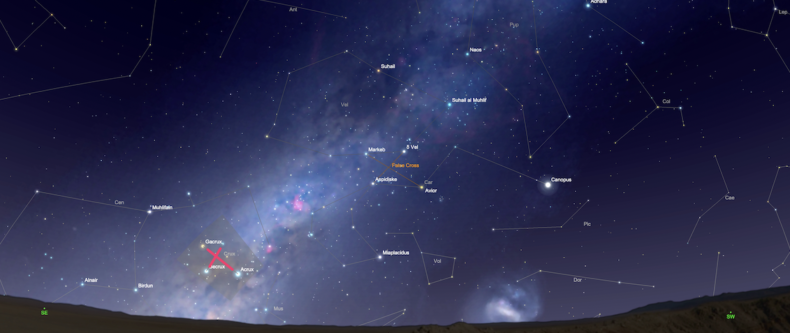
On the night of January 8, 1970, I was an A-37 attack jet pilot returning to my home base of Bien Hoa after a mission over the Mekong Delta in Vietnam. It was 1:30am as I reduced the power to separate from my leader and then zoomed the aircraft to 20,000 feet so I could see further down the horizon. Looking over the canopy rail to my right, I saw the constellation Crux for the first time in my life. Also known as the Southern Cross, it was just poking up over the southern horizon. It appeared as an X cross with a bright star at each end, just like I’d expected it would be. At my 11 o’clock, I spotted a white smudge, which I took to be the Large Magellanic Cloud (LMC). I had always wanted to see the Southern Cross and to see it under those circumstances was special — it was something good happening in the midst of war.
On subsequent flights, I’d repeat the “Crux zoom” to see the Crux and LMC again. By flying higher, I could see lower in the southern horizon. I told some of my fellow pilots what I’d seen, and soon they were trying the “Crux zoom” too. The Southern Cross is a constellation prized by northern observers. It was like going to a celestial art museum in the middle of the Vietnam War.
I spent 20 years in the Air Force, and after retiring, I flew for American Airlines for 16 years. I would often fly to the Southern Hemisphere — to Santiago, Chile; San Paulo, Brazil and Lima, Peru. As I flew down the west coast of South America, the Crux would be on the horizon for the entire flight and I would remember that first time viewing the Crux, a memory that has never left me. After 20 years of flying jets for the military, it was gratifying to finally get a chance to use airplanes to do something I’ve loved since I was a Kansas farm boy — observe the night sky.
**
Dee W. Friesen, Lt. Col, retired, USAF, is past president of the Albuquerque Astronomical Society and adjunct professor of physics and astronomy at Embry-Riddle Aeronautical University. For many years, he taught a course on the physic of aviation at New Mexico Tech University. He’s the father of LWON member Christie Aschwanden, who thinks she probably inherited her love of science from him. The annular eclipse happening this October comes right through his home in Albuquerque, where he’ll watch with friends. He spoke about the last one on NPR and here at LWON.
Image: Thanks to Carl Larson for using some planetarium software to recreate the view of Crux that Dee describes in this essay.
I finally looked at the picture of the sky (I look at words before pictures) and my my my goodness sakes! I wouldn’t have seen the difference in skies (I don’t keep track of stars and in the city I can’t see the Milky Way) until I saw that little good-grief galaxy down there. What’s a whole galaxy (I know, I’m not counting the Milky Way) doing in my sky? Lovely, lovely post.
Welcome home, Lt Col Friesen. I was never in control of an aircraft but, had I ever been in control of an aircraft, I might have done the same thing. Thank you for the movie playing in my mind.
What an amazing universe we live in! Enough to shut down that thinking process and just stare/ponder/drool. As one who’s never seen the Southern Cross or the LMC, thank you, Dee! Beautiful story.